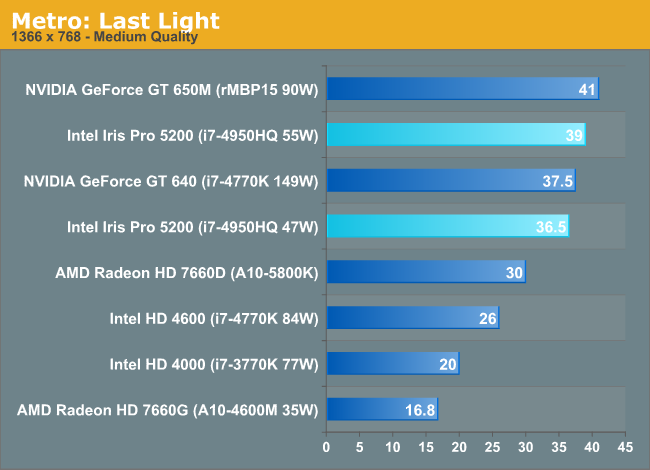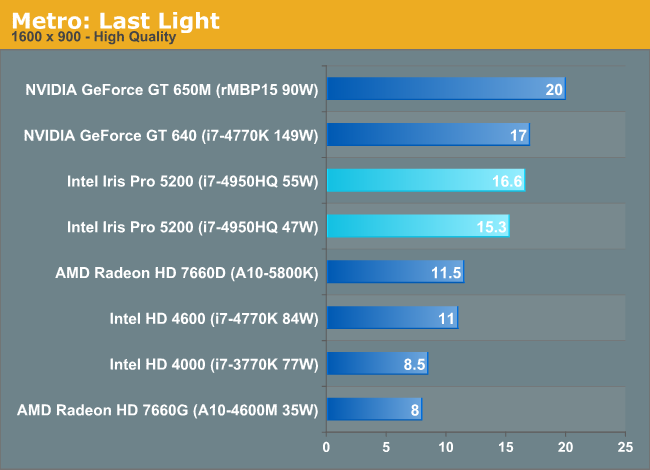Intel Iris Pro 5200 Graphics Review: Core i7-4950HQ Tested
by Anand Lal Shimpi on June 1, 2013 10:01 AM ESTMetro: Last Light
Metro: Last Light is the latest entry in the Metro series of post-apocalyptic shooters by developer 4A Games. Like its processor, Last Light is a game that sets a high bar for visual quality, and at its highest settings an equally high bar for system requirements thanks to its advanced lighting system. This doesn’t preclude it from running on iGPUs thanks to the fact that it scales down rather well, but it does mean that we have to run at fairly low resolutions to get a playable framerate.

Metro is a pretty heavy game to begin with, but Iris Pro starts off with an extremely good showing here. In its 55W configuration, Iris Pro is only 5% slower than the GeForce GT 650M. At 47W the gap is larger at 11% however. At 1366 x 768 the difference seems less memory bandwidth related and has more to do with efficiency of the graphics hardware itself.
The comparison to mobile Trinity is a walk in the park for Iris Pro. Even a 100W desktop Trinity part is appreciably slower here.

Increasing the resolution and quality settings changes things quite a bit. The 650M pulls ahead, and now the Iris Pro 5200 basically equals the performance of the GT 640. Intel claims a very high hit rate on the L4 cache, however it could be that 50GB/s is just not enough bandwidth between the GPU and Crystalwell. The performance improvement compared to all other processor graphics solutions, regardless of TDP, is still well in favor of Iris Pro. The i7-4950HQ holds a 50% advantage over the desktop i7-4770K and is almost 2x the speed of the i7-3770K.
Comparing mobile to mobile, Iris Pro delivers over 2x the frame rate of Trinity.










177 Comments
View All Comments
8steve8 - Saturday, June 1, 2013 - link
Great work intel, and great review anand.As a fan of low power and small form factor high performance pcs, I'm excited about the 4770R.
my question is how do we get a system with 4770R ?
will it be in an NUC, if so, when/info?
will there be mini-itx motherboards with it soldered on?
bill5 - Saturday, June 1, 2013 - link
Anand, would you say the lack of major performance improvement due to crystalwell bodes ill for Xbox one?The idea is ESRAM could make the 1.2 TF Xbox One GPU "punch above it's weight" with more efficiency due to the 32MB of low latency cache (ALU's will stall less waiting on data). However these results dont really show that for Haswell (the compute results that scale perfectly with ALU's for example).
Here note I'm distinguishing between the cache as bandwidth saver, I think we can all agree it will serve that purpose- and as actual performance enhancer. I'm interested in the latter for Xbox One.
Kevin G - Saturday, June 1, 2013 - link
A couple of quotes and comments from the article:"If Crystalwell demand is lower than expected, Intel still has a lot of quad-core GT3 Haswell die that it can sell and vice versa."
Intel is handicapping demand for GT3e parts by not shipping them in socketed form. I'd love to upgrade my i7-2600k system to a 4770K+GT3e+TSX setup. Seriously Intel, ship that part and take my money.
"The Crystalwell enabled graphics driver can choose to keep certain things out of the eDRAM. The frame buffer isn’t stored in eDRAM for example."
WTF?!? The eDRAM would be the ideal place to store various frequently used buffers. Having 128 MB of memory leaves plenty of room for streaming in textures as need be. The only reason not to hold the full frame buffer is if Intel has an aggressive tile based rendering design and only a tile is stored there. I suspect that Intel's driver team will change this in the future.
"An Ultrabook SKU with Crystalwell would make a ton of sense, but given where Ultrabooks are headed (price-wise) I’m not sure Intel could get any takers."
I bet Apple would ship a GT3e based part in the MacBook Air form factor. They'd do something like lower the GPU clocks to prevent it from melting but they want it. It wouldn't surprise me if Apple managed to negotiate a custom part from Intel again.
Ultimatley I'm pleased with GT3e. On the desktop I can see the GPU being used for OpenCL tasks like physics while my Radeon 7970 handles the rest of the graphics load. Or for anything else, I'd like GT3e for the massive L4 cache.
tipoo - Saturday, June 1, 2013 - link
"Ultimatley I'm pleased with GT3e. On the desktop I can see the GPU being used for OpenCL tasks like physics while my Radeon 7970 handles the rest of the graphics load. Or for anything else, I'd like GT3e for the massive L4 cache."I'd love that to work, but what developer would include that functionality for that niche setup?
Kevin G - Saturday, June 1, 2013 - link
OpenCL is supposed to be flexible enough that you can mix execution targets. This also includes the possibility of OpenCL drivers for CPU's in addition to those that use GPU's. At the very least, it'd be nice for a game or application to manually select the OpenCL target in some config file.Egg - Saturday, June 1, 2013 - link
I'm only a noob high school junior, but aren't frame buffers tossed after display? What would be the point of storing a frame buffer? You don't reuse the data in it at all. As far as I know, frame buffer != unpacked textures.Also, aren't most modern fully programmable GPUs not tile based at all?
Also, wasn't it mentioned that K-series parts don't have TSX?
Kevin G - Saturday, June 1, 2013 - link
The z-buffer in particular is written and often read. Deferred rendering also blends multiple buffers together and at 128 MB in size, a deferred render can keep several in that memory. AA algorithms also perform read/writes on the buffer. At some point, I do see Intel moving the various buffers into the 128 MB of eDRAM as drivers mature. In fairness, this change may not be universal to all games and dependent on things like resolution.Then again, it could be a true cache for the GPU. This would mean that the drivers do not explicitly store the frame buffers there but can could be stored there based upon prefetching of data. Intel's caching hierarchy is a bit weird as the CPU's L3 cache can also be used as a L4 cache for the GPU under HD2000/2500/3000/4000 parts. Presumably the eDRAM would be a L5 cache under the Sandy Bridge/Ivy Bridge schema. The eDRAM has been described as a victim cache though for GPU operations it would make sense to prefetch large amounts of data (textures, buffers). It'd be nice to get some clarification on this with Haswell.
PowerVR is still tile based. Previous Intel integrated solutions were also tile base though they dropped that with the HD line (and I can't remember if the GMA line was tile based as well).
And you are correct that the K series don't have TSX, hence why I'd like a 4770K with GT3e and TSX. Also I forgot to throw in VT-d since that too is arbitrarily disabled in the K series.
IntelUser2000 - Sunday, June 2, 2013 - link
Kevin G: Intel dropped the Tile-based rendering in the GMA 3 series generation back in 2006. Although, their Tile rendering was different from PowerVR's.Egg - Sunday, June 2, 2013 - link
Fair points - I was being a bit myopic and only thought about buffers persisting across frames, neglecting the fact that buffers often need to be reused within the process of rendering a single frame! Can you explain how the CPU's L3 cache is an L4 cache for the GPU? Does the GPU have its own L3 cache already?Also I don't know whether PowerVR's architecture is considered fully programmable yet. I know they have OpenCL capabilities, but reading http://www.anandtech.com/show/6112/qualcomms-quadc... I'm getting a vague feeling that it isn't as complete as GCN or Kepler, feature wise.
IntelUser2000 - Tuesday, June 4, 2013 - link
Gen 7, the Ivy Bridge generation, has its own L3 cache. So you have the LLC(which is L3 for the CPU), and its own L3. Haswell is Gen 7.5.